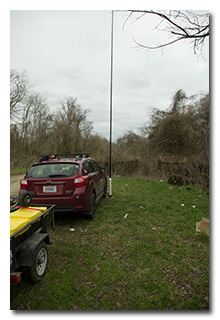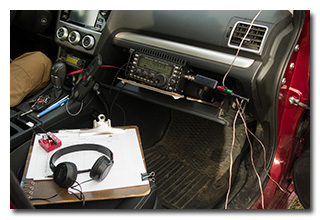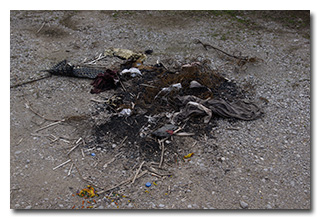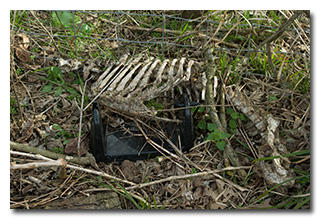
by William Eric McFadden
From the West Virginia Explorer entry:
-
The 1,096-acre Green Bottom Wildlife Management Area (WMA) protects a mix of forest, wetland, pasture, and open water along the Ohio River.
From the Lewis and Clark National Historic Trail website:
-
The Lewis and Clark National Historic Trail is approximately 4,900 miles long, extending from Pittsburgh, Pennsylvania, to the mouth of the Columbia River, near present day Astoria, Oregon. It follows the historic outbound and inbound routes of the Lewis and Clark Expedition as well as the preparatory section from Pittsburgh, Pennsylvania to Wood River, Illinois.
Pictures
- Eric's station; photo by Miles McFadden
- Eric's station
- Trash: 1 | 2
- Unloved toys: A Cabbage Patch Doll | A Troll Doll
- A rotting deer
Description
 On Saturday, March 11, 2023, two members of the Southeast Ohio Radio Adventure Team
performed successful simultaneous activations of Green Bottom Wildlife Management Area and Lewis and Clark
National Historic Trail in West Virginia as part of the Parks on the Air (POTA; link)
program.
On Saturday, March 11, 2023, two members of the Southeast Ohio Radio Adventure Team
performed successful simultaneous activations of Green Bottom Wildlife Management Area and Lewis and Clark
National Historic Trail in West Virginia as part of the Parks on the Air (POTA; link)
program.
Eric McFadden, WD8RIF, and Miles McFadden, KD8KNC, visited Green Bottom Wildlife Management Area along the banks of the Ohio River on a cold, windy, overcast day to perform the simultaneous activations of Green Bottom Wildlife Management Area and Lewis and Clark National Historic Trail following a visit to Bidwell, Ohio, for the MOVARC Hamfest and a two-fer activation of Tu-Endie-Wei State Park and Lewis and Clark National Historic Trail at the state park in Point Pleasant, WV (link). Eric and Miles were accompanied by little dog Theo.
Eric, Miles, and Theo arrived at the end of the badly-rutted Wetland Boat Ramp Road within Green Bottom Wildlife Management Area at about 2010 UTC to find the place to be an absolute sea of trash and mud. After Miles found a place (relatively) free of trash and mud to park his car, he and Eric deployed the 28½' wire vertical on the 31' Jackite telescoping fiberglass mast supported on a drive-on base. Because of the cold wind, Eric chose to set up his KX3 inside the car, and was on the air at 2016 UTC.
Eric was pleased to find he had sufficient cell-signal to view the POTA Spots website (link) and to spot himself and to check POTA Spots for park-to-park (P2P) QSO opportunities.
Because of the band-conditions he had just experienced at Tu-Endie-Wei State Park (link), Eric fully expected this two-fer activation to be a slog, with just ten or eleven stations logged.
Eric started his operation by checking POTA Spots for P2P QSO opportunities, and at 2017 UTC he made a P2P QSO on 20m with K0BWR who was activating Cooley Lake State Conservation Area (K-6476) in Missouri.
 After finding himself a frequency to run on 40m, Eric began calling "CQ POTA" and noticed that, just
as at Tu-Endie-Wei State Park, the RBN-driven auto-spot feature of POTA Spots was not working. After
spotting himself, Eric's first QSO in this run came at 2032 UTC with KG8P in Michigan. Initially,
QSOs came very slowly, with Eric's eleventh QSO in this run coming twenty-two minutes later at 2054 UTC
with N4SD in Virginia. Then, just as if a big switch had been thrown, QSOs started to come almost
too fast to log, with the next forty-one QSOs coming in only thirty-seven minutes, and Eric's fifty-third
and final QSO coming at 2133 UTC with N9QB in Wisconsin. This run included a DX QSO with an EA2DDG
in Spain; a P2P QSO with WE4AUB who was activating Cohutta Wildlife Management Area (K-7446)
in Georgia; a P2P QSO with WB2SMK who was activating Mohawk River State Park (K-8071) in New York; and
QSOs with operators located in Michigan, Wisconsin (7), Ontario (4), Georgia (4), New Jersey (2),
Connecticut (2), Kansas, California, Virginia (2), Massachusetts, Florida (6), Minnesota (3),
New York (4), South Carolina (2), Arkansas (2), Iowa, Idaho, Maine, Illinois (2), Texas, Missouri,
Tennessee, and New Hampshire.
After finding himself a frequency to run on 40m, Eric began calling "CQ POTA" and noticed that, just
as at Tu-Endie-Wei State Park, the RBN-driven auto-spot feature of POTA Spots was not working. After
spotting himself, Eric's first QSO in this run came at 2032 UTC with KG8P in Michigan. Initially,
QSOs came very slowly, with Eric's eleventh QSO in this run coming twenty-two minutes later at 2054 UTC
with N4SD in Virginia. Then, just as if a big switch had been thrown, QSOs started to come almost
too fast to log, with the next forty-one QSOs coming in only thirty-seven minutes, and Eric's fifty-third
and final QSO coming at 2133 UTC with N9QB in Wisconsin. This run included a DX QSO with an EA2DDG
in Spain; a P2P QSO with WE4AUB who was activating Cohutta Wildlife Management Area (K-7446)
in Georgia; a P2P QSO with WB2SMK who was activating Mohawk River State Park (K-8071) in New York; and
QSOs with operators located in Michigan, Wisconsin (7), Ontario (4), Georgia (4), New Jersey (2),
Connecticut (2), Kansas, California, Virginia (2), Massachusetts, Florida (6), Minnesota (3),
New York (4), South Carolina (2), Arkansas (2), Iowa, Idaho, Maine, Illinois (2), Texas, Missouri,
Tennessee, and New Hampshire.
Eric is at a loss to explain the sudden change in QSO-rate but suspects both a change in ionospheric conditions following recent solar flare activity and some generous hams updating Eric's spot on POTA Spots had something to do with the change.
In all, Eric made fifty-three QSOs in about an 75 minutes of on-air time. All of Eric's QSOs were CW and were made at the 5-watt level.
Miles did not operate but performed all of the driving, helped with set-up and tear-down, did much much of the activation photography, and tended to the needs of little dog Theo.
Eric, who usually espouses the "leave it better than you found it" ethic, was hurt to find this portion of Green Bottom Wildlife Management Area to be so badly trashed, but there was so much trash that even if Eric and Miles had been able to take some of it away with them in the already full car and trailer, it wouldn't have even been noticeable. A large truck and a crew would be required to clean up the area.
(return)




